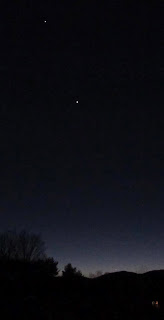
Every night over the next week, Mercury shines very low in the west at 7:00 p.m. Venus and Jupiter lie much higher in the sky and are much brighter. Do not expect little Mercury to stand out noticeably in the bright twilight. Look carefully for it about 15 degrees above the horizon. How high is 15 degrees? Outstretch your hand on your fully extended arm. The angular distance between the tips of the thumb and little finger is 20 degrees. So, 15 degrees is 3/4 that distance.
In the image, Mercury lies almost hugging the mountain ridge line. Definitely a challenge!
A pair of binoculars will aid in finding Mercury. Good hunting!
Such is our view from Earth...




